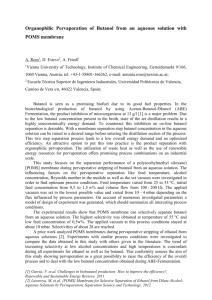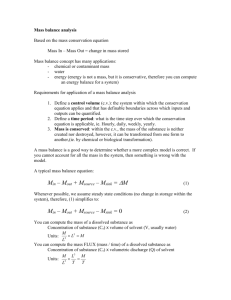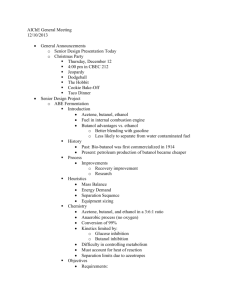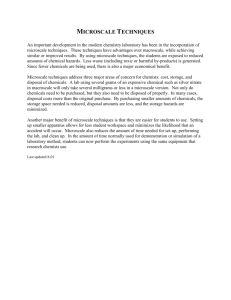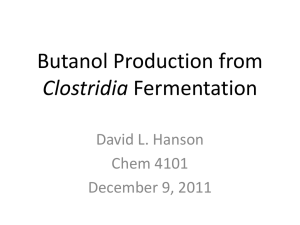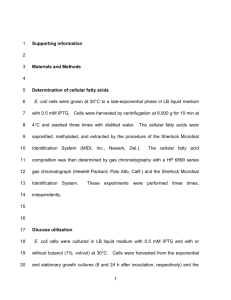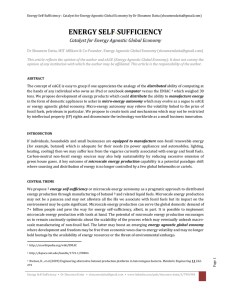ENERGY SELF SUFFICIENCY Economy, Energy, Education, Entrepreneurship and Employment
advertisement
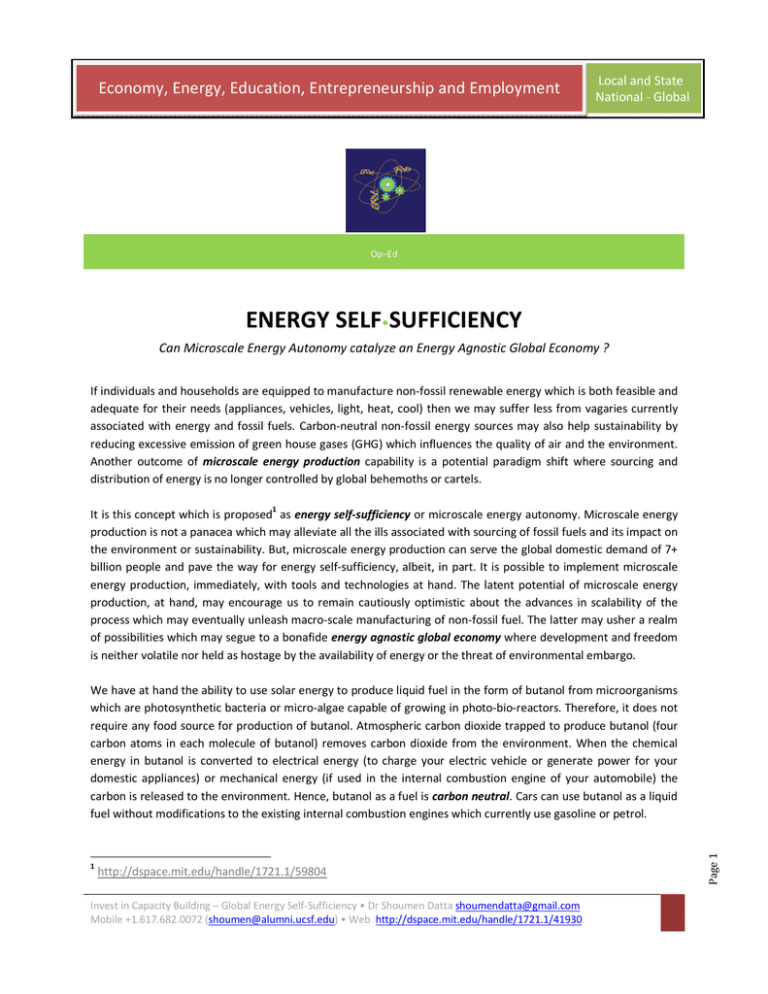
Economy, Energy, Education, Entrepreneurship and Employment Local and State National - Global Op–Ed ENERGY SELF•SUFFICIENCY Can Microscale Energy Autonomy catalyze an Energy Agnostic Global Economy ? If individuals and households are equipped to manufacture non-fossil renewable energy which is both feasible and adequate for their needs (appliances, vehicles, light, heat, cool) then we may suffer less from vagaries currently associated with energy and fossil fuels. Carbon-neutral non-fossil energy sources may also help sustainability by reducing excessive emission of green house gases (GHG) which influences the quality of air and the environment. Another outcome of microscale energy production capability is a potential paradigm shift where sourcing and distribution of energy is no longer controlled by global behemoths or cartels. It is this concept which is proposed1 as energy self-sufficiency or microscale energy autonomy. Microscale energy production is not a panacea which may alleviate all the ills associated with sourcing of fossil fuels and its impact on the environment or sustainability. But, microscale energy production can serve the global domestic demand of 7+ billion people and pave the way for energy self-sufficiency, albeit, in part. It is possible to implement microscale energy production, immediately, with tools and technologies at hand. The latent potential of microscale energy production, at hand, may encourage us to remain cautiously optimistic about the advances in scalability of the process which may eventually unleash macro-scale manufacturing of non-fossil fuel. The latter may usher a realm of possibilities which may segue to a bonafide energy agnostic global economy where development and freedom is neither volatile nor held as hostage by the availability of energy or the threat of environmental embargo. 1 http://dspace.mit.edu/handle/1721.1/59804 Invest in Capacity Building – Global Energy Self-Sufficiency • Dr Shoumen Datta shoumendatta@gmail.com Mobile +1.617.682.0072 (shoumen@alumni.ucsf.edu) • Web http://dspace.mit.edu/handle/1721.1/41930 Page 1 We have at hand the ability to use solar energy to produce liquid fuel in the form of butanol from microorganisms which are photosynthetic bacteria or micro-algae capable of growing in photo-bio-reactors. Therefore, it does not require any food source for production of butanol. Atmospheric carbon dioxide trapped to produce butanol (four carbon atoms in each molecule of butanol) removes carbon dioxide from the environment. When the chemical energy in butanol is converted to electrical energy (to charge your electric vehicle or generate power for your domestic appliances) or mechanical energy (if used in the internal combustion engine of your automobile) the carbon is released to the environment. Hence, butanol as a fuel is carbon neutral. Cars can use butanol as a liquid fuel without modifications to the existing internal combustion engines which currently use gasoline or petrol. Economy, Energy, Education, Entrepreneurship and Employment Local and State National - Global Butanol (or related products) produced by microorganisms were engineered to optimize production. But, the yield of butanol from photo bio-reactors (uses sun light as the source of energy) is low. Hence, the debate whether this method is scalable for mass production. The suggestion here is to transform this handicap into a key advantage. Small scale or microscale energy production serves the distributed concept advocated as energy self-sufficiency. If every household produced some energy or enough, then, scalability may not be a real impediment. Excess energy may be sold or auctioned by individuals (or cooperatives) to the smart grid, where available, in a manner envisaged for local wind or geothermal energy producers. Bio-energy tools at hand offers an immense potential to grow an energy cottage industry which may liberate the economies of the developing world and improve the lives of 80% of the global population whose ability to earn even a basic living is eviscerated by and is at the mercy of fuel prices. The developed and industrialized nations where sunlight is less abundant (low insolation zones in US and EU) may view the dependence on solar energy with chagrin. At hand, there is an elegant alternative which may be a driver for the next generation of energy supply chain. The solution is glucose, a molecule with 6 carbon atoms and the universal currency for energy in most biological systems. It is established that glucose can be converted by bacteria to butanol without sunlight. Photosynthetic microorganisms (cyano-bacteria) can produce glucose in the presence of sunlight. Hence glucose, instead of butanol, may be produced by bacteria in high insolation zones. Glucose (instead of liquid butanol) may be transported (solid) to low insolation zones where it may serve as the key commodity for solar-independent microscale butanol production. It is neither elusive nor requires any imagination to visualize the economic growth potential in the tropics from new lines of business which may spawn in high insolation zones capable of manufacturing energy, both in the form of butanol and glucose using renewable sources (sunlight, atmospheric carbon dioxide). Glucose as a commodity in the energy supply chain is non-perishable and amenable to storage. Hence, glucose serves both as a currency for energy and as an ammunition against economic volatility due to global energy uncertainty. Taken together, energy cottage industry could accelerate the development and economic freedom to develop nations on the continent of Africa (minimal grid), South and Central America, parts of South-East Asia, China and the Indian sub-continent, that is, most of the world. From a product marketing perspective, the latter is also the market for this product(s). Patent protection of intellectual property (IP) rights may stifle dissemination of work in progress. It may reduce options for other groups to pursue cooperative funding from semi-altruistic investors. The principles of butanol or related liquid bio-fuel (pentanol) production in bacteria are based on a vast body of existing scientific literature. Anywhere in the world, biotech experts can optimize butanol or glucose producing bacteria or micro-algae using tools of recombinant DNA or create bacterial strains (without IP) using metabolic engineering, RNA interference techniques and genomics. Adaptation or modification of photo bio-reactors for micro-scale bio-energy production and extraction of liquid fuel may not be a hurdle for an innovative team of chemical and mechanical engineers. Invest in Capacity Building – Global Energy Self-Sufficiency • Dr Shoumen Datta shoumendatta@gmail.com Mobile +1.617.682.0072 (shoumen@alumni.ucsf.edu) • Web http://dspace.mit.edu/handle/1721.1/41930 Page 2 Thus, one may wonder why this globally transforming energy solution and lucrative business opportunity is still not a part of our daily life. Few individuals are familiar with the science and engineering of bio-energy production. Those who have engineered the microorganisms are still perfecting the science and pursuing other optimizations. The convergence of energy biotechnology with metabolic and chemical engineering may experience growing pains. Investors are likely to push for macro-scale mass production volumes. Hence, the penchant for domestic, low-cost, micro-scale energy production “kitchen” appliance or “garden” generator may not be under consideration. Above all, the cost per kilo-watt-hour of electricity generated from an unit (liter/gallon) of butanol or glucose (g/kg) may be the most intensely debated and analyzed factor which could contribute to the canonical paralysis by analysis. Economy, Energy, Education, Entrepreneurship and Employment Local and State National - Global The idea of energy self-sufficiency, therefore, is neither a virtual concept nor an experiment. It is possible, here and now. The road to success depends on leadership with a vision that distributes power rather than consolidating it in the hands of a few. Hence, this is also a call for visionary investors or organizations to fuel teams who can deliver the products aimed at distributing bio-energy manufacturing and building capacity for global energy autonomy. Distributed microscale energy manufacturing proposal is analogous to the distributed ability of computing at the hands of each individual who owns an iPad or notebook computer versus the ENIAC which weighed 30 tons in 1946, at the dawn of the information age (iAGE). Products which will distribute the ability to manufacture energy will usher in the energy agnostic global economy (eAGE). Investors agonizing over scalability cost (per kilowatthour) may wish to review the history of memory (RAM) and VCR. 1MB RAM in 1957 cost $411 million but in 2010 it declined to only 1 cent per 1MB RAM. The first VCR manufactured, by AMPEX in 1956, cost $50,000.00 each. VCR production ceased in 2006 due to decline in price. Despite the global gains from liquid energy manufacturing, no matter how disruptive the distributed concept may seem at present these advantages are temporary and may cease to deliver value in 100 years or less. The following advances may also, abruptly, change the game: Nate Lewis, Codexis, Joule Unlimited optimization of solar energy capture or use rapid and safe deployment of fission reactors commercialization of laser-ignited fusion reactors bio-inspired mechanisms (electron transport chain) nano-material battery power storage with non-zero perishability energy capture by photo-voltaic films to directly generate hydrogen reproduction of photosynthesis in vitro or on-a-chip with appreciable efficiencies About the Author http://www.linkedin.com/pub/shoumen-datta/3/789/984 Dr Shoumen Datta is an academician, molecular biologist and biotechnologist by training with two decades of research experience in cancer biology, microbiology, neuro-endocrinology and human genome project. He earned his PhD from Rutgers University (UMDNJ) School of Medicine and was a scientist at Harvard Medical School, MIT and UCSF School of Medicine. He was a Research Fellow in Medicine at Massachusetts General Hospital (Boston, MA) and Instructor in Medicine at Harvard Medical School. Since 2000, he has been involved in software innovation in Silicon Valley (Palo Alto, California) and at MIT (School of Engineering) to develop decision frameworks applicable to healthcare, energy, security and business using the principles of artificial intelligence (AI) and engineering systems. He has taught at MIT School of Engineering (operations research) and at MIT Sloan School of Management (strategy, management) and extensively lectured (worldwide) on operations management and innovation in intelligent decision systems. In a parallel trajectory, Dr Datta is dedicated to improve education and entrepreneurship. He was catalytic in the outreach efforts at Harvard Medical School and MIT which produced unique collaborations with public schools in CambridgeBoston and contributed to the Whitehead Institute Teachers Program at MIT. In San Francisco, he created successful programs in bio-technology (collaboration between SFUSD & UCSF) and in networking (in collaboration with Cisco Systems which is now globally known as Cisco Networking Academy). Currently, he is pursuing projects in energy and healthcare informatics which may be constructively disruptive and create new jobs. Invest in Capacity Building – Global Energy Self-Sufficiency • Dr Shoumen Datta shoumendatta@gmail.com Mobile +1.617.682.0072 (shoumen@alumni.ucsf.edu) • Web http://dspace.mit.edu/handle/1721.1/41930 Page 3 But it remains a fact, that, at hand, at this time, distributed bio-energy manufacturing is one solution for a world where energy demand is increasing exponentially. What we can accomplish with microscale energy production in eAGE is comparable to the transformational global changes that followed when women gradually secured the right to vote in the 20th Century. Distributed micro-energy autonomy empowers global citizens to pursue development and economic freedom to build a better civilization. The grass may be greener on the other side, in the eAGE.

